Malia is one of the most touristic towns in Crete, located 35km east of Heraklion, on the outskirts of Mount Selena. Its name means “flat area”, because Malia is situated on a fertile plain. Indeed, it is famous throughout Greece for the delicious bananas grown in the greenhouses in the area. The valley has many springs and in the past was known for its windmills, used for watering the local potato crops.
Many years ago, Malia was a small coastal village with few residents. Malia has seen rapid growth in recent years and the town has expanded in all directions. Malia is known to tourists for the three “s” holidays, i.e. sand, sea, sex. Indeed, it is famous for the huge beach and the very lively nightlife, as thousands of young tourists drink in the clubs until dawn. In the early morning, Malia reminds of a bombed landscape with drunk youngs staggering and seeking the way to their hotel.
Malia has two main roads that meet at the center of town, in front of the church of Saint Nektarios. The first street is a pedestrian street connecting the old village with the beach. This is full of clubs and bars, where thousands of young tourists party every night. The second road is vertical to the first and is full of shops, cafes, supermarkets, banks, clinics, etc. Things here are much calmer.
Sightseeing
Apart from the wild nightlife, Malia is famous for the archaeological site of the third-largest Minoan palace in Crete, in position Chryssolakkos or Tarmaros, east of the village. The name Tarmaros is considered to be the name of the ancient city of the region. The Palace of Malia was controlled by the legendary King Sarpedon, who was the son of Zeus and goddess Europa and brother of King Minos (King of Knossos). The Sarpedon was once evicted by Minos and moved to Lycia, in Asia Minor, where he was worshiped as a god. The palace of Malia was destroyed in 1700BC, rebuilt, and re-destroyed in 1450BC. Tombs with many golden objects have been found. Among these, the archaeologists found the famous jewel with the bees, which is exhibited in the archaeological museum of Heraklion. Unfortunately, before the tombs were excavated, they were already looted and nobody knows how many wonderful items have been lost. Near the palace, traces of an early Christian basilica and a marble sarcophagus have been revealed.
Furthermore, in the old village of Malia, you can stroll in the narrow traditional streets and visit the church of Panagia Galatiani, which was built with milk instead of water. You can also see the churches of Saint John the Baptist, the Archangels, Saint Demetrios and the Annunciation, St. George, St. Pelagia and Saint Sava (near the shore). The Church of St. George at Loutres has many old frescoes and was built there to protect the locals from the elves. Lastly, on the island just opposite the beach of Malia, the Church of Transfiguration is a lovely place for photographs.
If you have a car, you should drive 15' north of Malia, to the traditional village Krassi. The route crosses a wild gorge with many carobs and oak trees. Krasi is famous for the huge plane tree of Krasi in the central square. You can drink your coffee in the square, eat in the taverns of the village and walk in the narrow streets. Lastly, at the square is a spring with clean cold water.
- 1
- 2
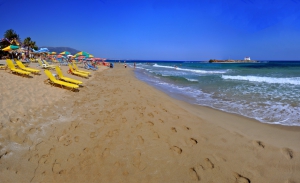
The beach of Malia is the eastern part of the vast beach (6km length) starting from Stalis. It is a wide beach with fine sand and shallow waters. It is so crowded that there is no space between the sunbeds to fit a pin! Here you can find whatever comfort you ask.
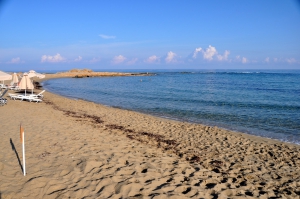
Potamos is a long sandy beach, very well organized, but less crowded than the main beach of Malia. The region, particularly its east part, is not developed due to the archaeological site. However, in the west of the beach, there are several hotels with small bays in front of them.
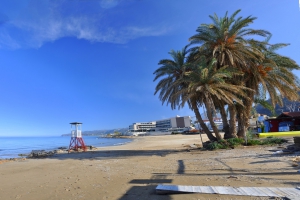
Stalis (or Stalida) is located 30km east of Heraklion, in the midway of Malia and Hersonissos. From a small seaside village set up by the residents of Mohos, Stalis is today a popular tourist resort, which is united with Malia town. The only difference with Malia is that Stalis attracts mainly families and things here are more peaceful.
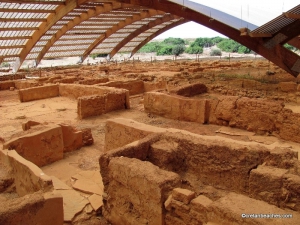
The archaeological site of Malia is located 3km east of Malia, next to the wetland of the area and very close to the beach. It was an important Minoan city and housed the third largest Minoan palace, after Knossos and Phaestus. According to mythology, Sarpedon reigned here, who was brother of Minos and son of Zeus and Europa. Sarpedon was expelled by his brother Minos and then took refuge in Lycia in Asia Minor.
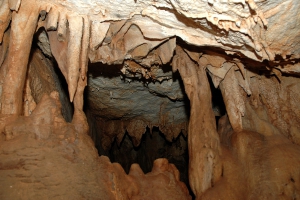
The orientation of the cave is south east and the temperature of the cave is high given the area. During the summer months the humidity of the cave is quite high. Its length is about 30m several narrow passages. From the first room in order to reach the main room, you have to pass through a very small opening. Life in the cave is not developed, probably due to many visitors.
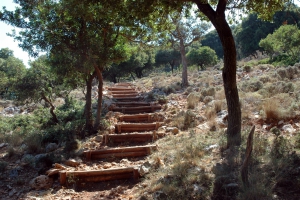
Chamoprina wood is a wood with low oak trees, located 4km south of Malia town. It can be accessed very easily from Malia, because it is located on the road connecting the old village of Malia with Krasi village.
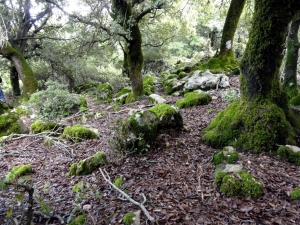
The holm oak wood (Azilakodasos) is located 11km west of Vrachasi and 9km south of Malia, in the foothills of Mount Selena. The small forest can be accessed either by walking the smooth path from Krassi village or by following the trail from Malia that runs uphill. There is also a small network of forest dirt roads in the area.
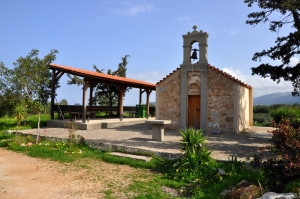
East of Malia, at position Loutres, there is the church of Saint George. The church is built on the site of a former church of the 9th century and dates back to Venetian period (13th century). Its interior bears frescoes, among them Saint George on his horse and various saints. On the walls we can discern engravings of the Medieval traveller (dates 1594,1613,1614 and 1616).
- 1
- 2














































































